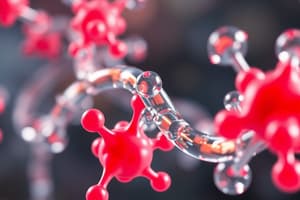Podcast
Questions and Answers
Which of the following statements is correct regarding viruses in relation to the characteristics of life?
Which of the following statements is correct regarding viruses in relation to the characteristics of life?
- Viruses lack cellular structure and cannot metabolize on their own. (correct)
- Viruses can reproduce independently without a host cell.
- Viruses are considered living organisms due to their ability to invade host cells.
- Viruses exhibit cellular organization and growth.
How do multicellular organisms differ from unicellular organisms?
How do multicellular organisms differ from unicellular organisms?
- Multicellular organisms can survive as independent cells, whereas unicellular organisms cannot.
- Multicellular organisms consist of specialized cells working together, while unicellular organisms function as a single unit. (correct)
- Multicellular organisms reproduce through binary fission, while unicellular organisms reproduce sexually.
- Multicellular organisms are made of a single cell, while unicellular organisms have multiple cells.
Which of the following properties of life is most directly involved in maintaining internal balance?
Which of the following properties of life is most directly involved in maintaining internal balance?
- Metabolism
- Growth and development
- Reproduction
- Homeostasis (correct)
What is the primary reason that all living organisms undergo metabolism?
What is the primary reason that all living organisms undergo metabolism?
In what way do organisms demonstrate responsiveness to their environment?
In what way do organisms demonstrate responsiveness to their environment?
What is the primary function of insulin in the body?
What is the primary function of insulin in the body?
Which of the following statements about heredity is true?
Which of the following statements about heredity is true?
What type of response is phototropism?
What type of response is phototropism?
Which of the following describes the process of cellular differentiation?
Which of the following describes the process of cellular differentiation?
What is an example of a physical adaptation in organisms?
What is an example of a physical adaptation in organisms?
Flashcards are hidden until you start studying
Study Notes
Characteristics of Life
- Living organisms are called biotic factors.
- Non-living things are called abiotic factors.
- Life is characterized by eight properties:
- Cellular organization: All living things are made up of cells, the smallest unit capable of life functions.
- Reproduction: All living things reproduce, making more of their own kind.
- Metabolism/Requires Energy: The sum of chemical reactions in an organism is metabolism, and these reactions require energy. Living things carry out chemical reactions to obtain and use energy.
- Homeostasis: Living organisms maintain a stable internal environment for proper functioning.
- Heredity: Living things pass on traits through genes, coded in DNA.
- Responsiveness: Living things respond to stimuli, such as light, touch, or temperature changes.
- Growth and development: Living things increase in size and mature over time. All organisms start as a single cell.
- Adaptations: Inherited changes that occur over time, helping species survive. This increases their ability to pass on genes.
Examples of Homeostasis
- Organisms must maintain body stability for survival.
- When blood glucose levels are high, the body releases insulin to lower them.
- When there is excess waste in the blood, the body gets rid of it through urination.
- When body temperature increases, the body cools itself down by sweating.
- When it is too hot, plants close pores on their leaves to prevent dehydration.
Examples of Responsiveness
- Phototropism: Plants grow towards light.
- Phototaxis: Organisms move towards or away from light.
- Thigmotaxis: Organisms respond to contact or touch.
- Reflexes: Prevent animals from getting harmed, such as moving away from a hot source.
Examples of Adaptations
- Eye adaptation: The ability of the eye to adjust to different levels of light.
- Behavioral adaptations: Changes in behavior to help an organism survive.
- Physical adaptations: Changes to an organism's body structure to help it survive.
Viruses and Life
- Viruses are not considered living organisms because they cannot reproduce on their own.
- They are not made up of cells, cannot grow, and cannot metabolize.
- They need to take over a host cell to reproduce.
Studying That Suits You
Use AI to generate personalized quizzes and flashcards to suit your learning preferences.




